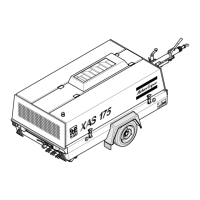- 61 -
13. Excessive compressor oil
consumption.Oil mist being
discharged from air outlet valve(s).
a. Restrictor in oil scavenging line (SL) clogged.
b. Oil separator element (OS) defective.
c. Oil level too high.
d. Non return valve missing in scavenge line.
a. Dismount, clean and refit restrictor.
b. Replace element.
c. Check for overfilling. Release pressure and drain oil to
correct level.
d. Install non return valve.
14. Compressor shuts down through a
shutdown switch.
a. Alternator V-belt broken or slipping.
b. Compressor overheating.
c. Engine oil pressure too low.
d. Engine temperature too high.
e. Low coolant level.
a. Re-tense or replace V-belt.
b. See condition 14.
c. Check lubricating system.
d. Check engine coolant system; see Engine Operation
Manual.
e. Top up cooling system.
15. Air and oil mist expelled from air filter
after stopping.
a. Unloader valve (UV) blocked.
b. Wrong oil type (without foam-retarding additives).
a. Repair valve.
b. Consult Atlas Copco.
16. Compressor overheating; alarm lamp
(H2) goes on.
a. Insufficient compressor cooling.
b. Oil cooler (OC) clogged externally.
c. Oil system clogged internally.
d. Oil level too low.
e. Incorrect working of temperature safety switch.
f. Cooling fan defect.
g. Incorrect oil specification.
a. Relocate compressor.
b. Clean cooler; see section Cleaning coolers.
c. Consult Atlas Copco.
d. See section Oil level check in the Operator manual.
e. Check temperature safety switch; if necessary replace.
f. Replace cooling fan.
g. Observe recommended oil specification.
17. Engine overheating; alarm lamp (H1)
goes on.
a. Insufficient engine cooling.
b. Engine coolant cooler clogged externally.
c. Incorrect working of temperature safety switch.
d. Cooling fan defect.
a. Relocate compressor.
b. Clean engine coolant cooler. Refer to section Cleaning
coolers.
c. Check temperature safety switch; if necessary replace.
d. Replace cooling fan.
18. No air output. a. Consult authorized technician/Atlas Copco.
Problem Possible faults Corrective actions

